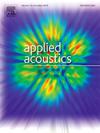Nonlinear ultrasonic testing of concrete damage based on the stress–strain relationship of concrete hysteresis in non-classical nonlinear models
IF 3.4
2区 物理与天体物理
Q1 ACOUSTICS
引用次数: 0
Abstract
In the context of applying nonlinear ultrasonic detection to concrete damage, the nonlinear coefficients derived from theoretical models are of paramount importance. This study incorporates the nonclassical nonlinear hysteresis stress–strain relationship of concrete materials into the wave equation, combines boundary conditions, employs perturbation methods, and derives the hysteresis nonlinear coefficients δ1 and δ2. Considering the existing classical nonlinear coefficient β and the clapping nonlinear coefficient γ, nonlinear ultrasonic tests were conducted on pre-cracked concrete. Upon analysis of the test results, it was observed that the overall trends of the three nonlinear coefficients exhibited an increase with crack length and a decrease with crack angle. A comparison of the damage characterization performance of the three coefficients reveals that both the classical and the clapping nonlinear coefficient exhibit fluctuations during the damage changes. Whereas, the hysteresis nonlinear coefficients are capable of consistently representing the trend of damage evolution. The hysteresis nonlinear coefficients not only respond sensitively to changes in concrete damage but also clearly represent the changing trend of damage with minimal fluctuations and high robustness. Consequently, they are more suitable for damage detection in concrete materials. Furthermore, this conclusion is validated in both microcrack and multi-crack scenarios.
基于非经典非线性模型混凝土迟滞应力-应变关系的混凝土损伤非线性超声检测
在将非线性超声检测应用于混凝土损伤中,由理论模型推导出的非线性系数是至关重要的。本研究将混凝土材料的非经典非线性迟滞应力-应变关系纳入波动方程,结合边界条件,采用微扰方法,推导出迟滞非线性系数δ1和δ2。考虑已有的经典非线性系数β和拍打非线性系数γ,对预裂混凝土进行了非线性超声试验。通过对试验结果的分析可以看出,三个非线性系数的总体趋势是随着裂纹长度的增加而增大,随着裂纹角度的减小而减小。对三种非线性系数的损伤表征性能进行了比较,结果表明经典非线性系数和鼓掌非线性系数在损伤变化过程中均表现出波动。而迟滞非线性系数能较好地反映损伤的演化趋势。迟滞非线性系数不仅对混凝土损伤变化响应灵敏,而且能清晰地反映损伤变化趋势,波动小,鲁棒性强。因此,它们更适合于混凝土材料的损伤检测。此外,这一结论在微裂纹和多裂纹两种情况下都得到了验证。
本文章由计算机程序翻译,如有差异,请以英文原文为准。
求助全文
约1分钟内获得全文
求助全文
来源期刊

Applied Acoustics
物理-声学
CiteScore
7.40
自引率
11.80%
发文量
618
审稿时长
7.5 months
期刊介绍:
Since its launch in 1968, Applied Acoustics has been publishing high quality research papers providing state-of-the-art coverage of research findings for engineers and scientists involved in applications of acoustics in the widest sense.
Applied Acoustics looks not only at recent developments in the understanding of acoustics but also at ways of exploiting that understanding. The Journal aims to encourage the exchange of practical experience through publication and in so doing creates a fund of technological information that can be used for solving related problems. The presentation of information in graphical or tabular form is especially encouraged. If a report of a mathematical development is a necessary part of a paper it is important to ensure that it is there only as an integral part of a practical solution to a problem and is supported by data. Applied Acoustics encourages the exchange of practical experience in the following ways: • Complete Papers • Short Technical Notes • Review Articles; and thereby provides a wealth of technological information that can be used to solve related problems.
Manuscripts that address all fields of applications of acoustics ranging from medicine and NDT to the environment and buildings are welcome.
 求助内容:
求助内容: 应助结果提醒方式:
应助结果提醒方式:


